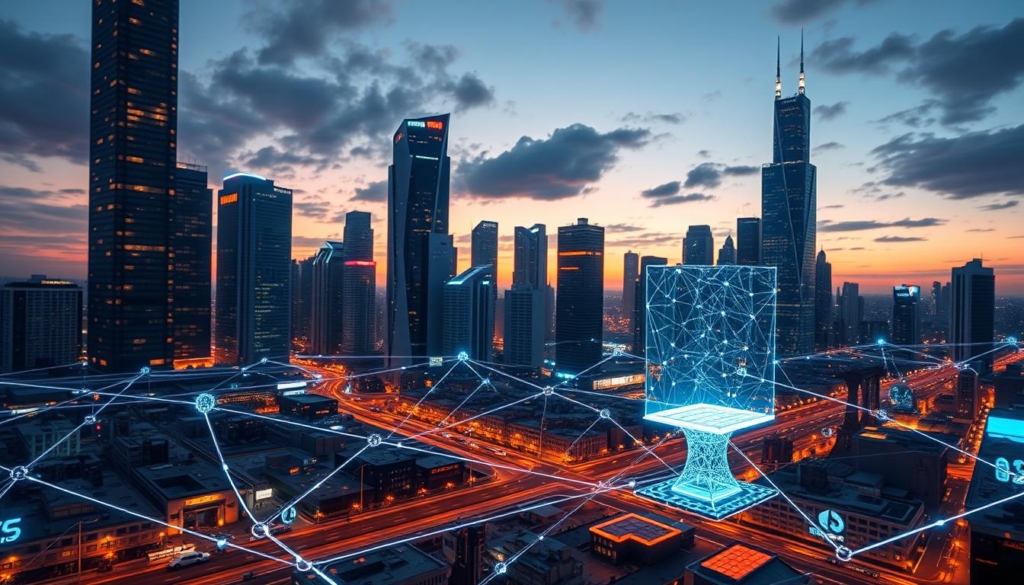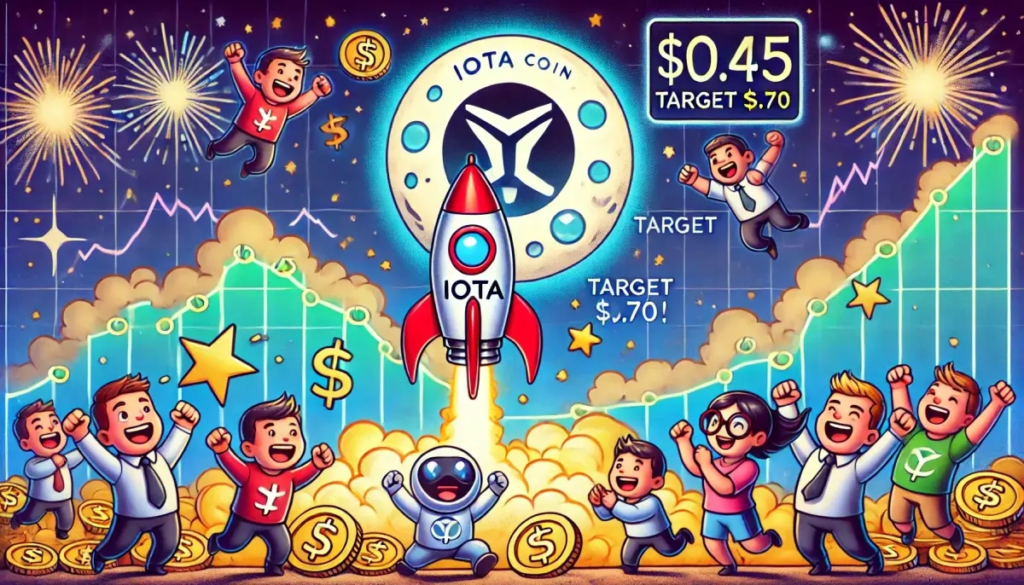IOTA is a new way to connect devices online, using blockchain technology. It was started in 2015 by the IOTA Foundation in Germany. This group works to make the internet of things (IoT) work better.
IOTA uses a special structure called the Tangle. It’s different from other blockchains. This design helps devices talk to each other without paying fees. It makes the IoT system more efficient and cost-effective.
Key Takeaways
- IOTA’s Tangle architecture replaces blockchain’s blocks with parallel transaction processing, reducing latency and enhancing scalability.
- As IoT devices approach 17 billion by 2030, IOTA’s feeless model supports seamless data exchange for smart cities, healthcare, and industrial systems.
- The IOTA Foundation focuses on advancing IoT connectivity through decentralized, energy-efficient protocols without transaction fees.
- Blockchain and IoT integration via IOTA improves data security and interoperability, as seen in healthcare’s use of electronic health records and clinical trials.
- IOTA 2.0 upgrades, including smart contracts like Authority and Access Control, strengthen security and efficiency for real-world applications.
Understanding IOTA: The Blockchain for Internet of Things
In 2015, IOTA technology was born as a special blockchain for the internet of things. It was made for devices to talk to each other. Old blockchains like Bitcoin were too expensive and used too much energy for IoT’s huge networks.
IOTA’s creators wanted a system where tiny payments and data exchanges could happen fast and for free. They dreamed of a world where billions of devices could communicate without any cost.

The Origins and Vision Behind IOTA
The IOTA Foundation, a nonprofit, aimed for scalability and ease of use from the start. They changed the blockchain’s structure to the Tangle, a directed acyclic graph (DAG). This move got rid of mining and fees.
Now, billions of devices can work together to check transactions. This solves the big problems of IoT.
Core innovations include:
- Feeless microtransactions for low-power devices
- Decentralized identity solutions compliant with W3C standards
- Partnerships with organizations like Walt.id to expand real-world use
In 2024, IOTA Identity was adopted by the European Blockchain Sandbox. This shows it’s ready for rules. It lets users control their digital identities with decentralized identifiers (DIDs).
This makes IoT systems more trustworthy. A 2023 update, MoveVM, made smart contracts safer without slowing things down. With over 10,000 nodes worldwide, IOTA is getting closer to its goal of a seamless machine economy.
Review of IOTA: IoT and Blockchain Integration
IOTA analysis shows promise in merging IoT and blockchain. Its Tangle architecture eliminates transaction fees. This is key for IoT’s massive data streams.
With over 17 billion IoT devices expected by 2030, IOTA’s model could cut costs. This is for smart grids, autonomous vehicles, and industrial sensors.

- Strengths: Zero-fee transactions, quantum-resistant cryptography, and offline transaction capabilities.
- Challenges: Past security flaws and reliance on the Coordinator for network stability.
IOTA review highlights its unique approach. Unlike traditional blockchains, the Tangle’s scalability improves with more users. This is crucial for IoT’s growing networks.
Partnerships with Bosch and Dell show its industry traction. However, critics question its decentralization and real-world stress-testing under high traffic.
Key applications include supply chain tracking and energy grids. IOTA’s Chronicle and IOTA Streams tools ensure secure data handling. While blockchain’s immutability strengthens IoT security, IOTA’s offline functionality enables devices in remote areas to sync later.
Core Technology Powering IOTA’s Ecosystem
Theiota technologyecosystem is built on the Tangle architecture. It’s different from traditionalblockchain for iot solutionsbecause it uses a directed acyclic graph (DAG) instead of block chains. This design means no transaction fees and no miners, making it perfect for IoT’s big data needs.
The Tangle Explained: IOTA’s Directed Acyclic Graph
The Tangle works by making every new transaction validate two old ones. This creates a self-sustaining network. As more devices join, the system gets faster and safer. Here’s how it works:
- No transaction fees enable micropayments between devices
- Scalability grows with network activity
- Real-time data processing for connected systems
| Feature | Traditional Blockchain | IOTA Tangle |
|---|---|---|
| Transaction Fees | Required | Zero fees |
| Scalability | Restricted by block limits | Unlimited throughput |
| Validation | Miners approve blocks | Users validate transactions |
| IoT Suitability | High costs for small data | Optimized for device networks |
The Tangle’s DAG structure makes data storage tamper-proof, key for IoT’s device-to-device communication. It supports real-world uses like autonomous vehicles sharing traffic data or smart grids managing energy without cost barriers.
By avoiding blockchain’s energy-intensive mining, the iota platform saves energy while keeping data safe. This makes it a top choice for 6G-ready IoT networks needing fast, free transactions.
Key Features and Benefits of the IOTA Platform
The IOTA platform offers iota features that solve big problems in IoT. Its core, the Tangle, gets rid of transaction fees. This makes it perfect for big IoT networks.
- Feeless Transactions: No cost for data moves means less spending. It opens up tiny deals between devices like sensors or smart meters.
- Scalability: The Tangle grows easily, handling lots of transactions fast without getting slow.
- Offline Functionality: Devices work well even without internet. This is great for places that are hard to reach.
- Quantum Resistance: It uses top-notch encryption to protect against future threats from quantum computers.
- Data Marketplace: A place where devices can sell their data. This creates new ways for businesses to make money.
The iota features lead to big iota benefits. For makers, no fees mean less money spent. Fast transactions help with things like paying for self-driving cars. The iota platform also works with global standards, making it easy to use worldwide.
After 2021, updates made the network even better. It’s now more stable. Working with big names like Walt.id shows it’s a top choice for IoT.
IOTA makes IoT systems grow without the usual blockchain problems. It’s ready for the future with quantum-safe tech and works offline. This makes it a top pick for IoT projects.
IOTA Use Cases: Real-World Applications
IOTA’s iota use cases cover many areas, showing how internet of things blockchain can solve today’s problems. It’s used in smart buildings and energy systems, making them more efficient and trustworthy.
Smart Cities and Infrastructure
Smart cities use blockchain for iot solutions to run smoothly. IOTA’s free transactions help with smart parking, reducing traffic. It also tracks air and waste quality in real-time.
Energy grids use IOTA to share renewable energy, saving money and reducing pollution.
- Supply Chains: Walmart and IBM show how internet of things blockchain works. IOTA tracks food freshness, stopping fraud.
- Energy Markets: People can sell extra solar power to neighbors, thanks to IOTA.
- Healthcare: Medical devices share patient data safely, meeting GDPR rules.
“Decentralized systems are critical for IoT security. IOTA’s fee-less model removes barriers to innovation.” — IOTA Foundation Report, 2023
Autonomous cars use IOTA to share traffic info, making roads safer. While there are hurdles, IOTA is making a difference. It’s key in building a connected, decentralized world.
Challenges and Limitations in IOTA’s Approach
IOTA aims to link blockchain and IoT integration but faces challenges. Critics say its use of a central “Coordinator node” is a problem. This node temporarily checks transactions but makes IOTA less decentralized than other blockchains.
This issue worries big companies that want to use blockchain. They are skeptical because IOTA doesn’t follow blockchain’s main rules.
“Several of the design features of IOTA are unusual, and it is unclear whether they work in practice.”
Security Concerns and Past Vulnerabilities
There have been security issues in the past. In 2017, a bug in seed generation made wallets unsafe. In 2020, the Trinity Wallet was hacked, losing user money. These problems show that iot and blockchain integration security needs work.
- Centralized Coordinator node undermines trust in decentralization
- 2020 Trinity Wallet hack demonstrated critical vulnerabilities
- Slow ecosystem growth compared to Ethereum’s mature smart contract platform
| Challenge | IOTA’s Response |
|---|---|
| Coordinator dependency | Coordicide project aims to remove the Coordinator by Q1 2024 |
| Transaction spam risks | Proposed Proof-of-Work upgrades for spam mitigation |
| Enterprise adoption delays | Partnerships with Volkswagen and Cisco to validate use cases |
Experts doing iota analysis say IOTA’s free transactions are a double-edged sword. They save money but make it easier for spam attacks. To gain trust, iot and blockchain integration efforts must focus on both new ideas and solid security.
IOTA Cryptocurrency: The Digital Asset Landscape
At the heart of IOTA’s ecosystem lies iota cryptocurrency, a digital asset designed to fuel IoT innovation. Unlike traditional cryptocurrencies, IOTA’s digital assets on iota operate without transaction fees. This makes seamless microtransactions between devices possible. It also meets IoT’s need for low-cost, high-volume data exchanges.
IOTA’s token economy focuses on utility over speculation. It has a fixed supply of 2.779530244273664e+68 tokens, with no mining required. This eliminates energy waste. It contrasts sharply with Bitcoin’s Proof-of-Work or Ethereum’s energy-intensive consensus methods.
The token’s dual role as both a transactional tool and a store of value creates unique dynamics in its market performance.
“IOTA’s feeless transactions are a breakthrough for IoT, enabling billions of devices to transact without financial barriers.”
Market data highlights IOTA’s potential. Its review of iota: iot and blockchain integration shows adoption in sectors like supply chain and smart cities. However, volatility remains a concern, with price swings reflecting broader crypto market trends. Investors monitor exchanges like Binance and KuCoin for liquidity, while developers focus on ecosystem tools like the IOTA Wallet.
- Zero-fee transactions drive IoT adoption
- Fixed token supply avoids inflation risks
- Integration with Shimmer EVM and smart contracts expands use cases
Regulatory clarity is evolving. IOTA’s focus on utility—securing data and enabling M2M payments—positions it as a functional asset rather than a speculative one. Ongoing updates like Coordicide aim to decentralize governance, addressing prior centralization critiques.
As IOTA 2.0 rolls out, its iota cryptocurrency evolves alongside Tangle’s scalability upgrades. This synergy positions IOTA as a critical component in the IoT-driven economy, balancing innovation with real-world applications.
Conclusion: IOTA’s Place in the Future of Connected Devices
The Internet of Things (IoT) is set to grow to 50 billion devices by 2030. Iot and blockchain integration is key to this growth. IOTA’s Tangle architecture is designed for fast, feeless transactions and real-time data exchange. It’s a foundational layer for the internet of things blockchain systems.
IOTA’s DAG-based ledger means no transaction fees. This makes it great for big projects like managing energy grids and tracking supply chains. It does all this without the need for a central authority.
IOTA also has quantum-resistant cryptography and can handle transactions offline. This makes it better than traditional IoT systems at keeping data safe. The ReCert framework shows how internet of things blockchain can make distributed networks secure. It also helps reduce the need for cloud services.
Features like Mana’s reputation system and Coordicide’s full decentralization aim to make IOTA a leader in IoT security. This is crucial for billions of connected devices.
Despite past security issues and adoption challenges, IOTA is moving in the right direction. It’s working on lightweight protocols that fit with edge computing and 5G. This means it can handle lots of data without charging fees, opening up new possibilities in smart cities and industrial automation.
A iota review suggests it could become a standard in the industry. But, it needs to overcome technical hurdles and gain widespread use. The next few years will show if IOTA can make its vision of a seamless machine economy a reality.

